#amphibia lore
Explore tagged Tumblr posts
Text
Pre-Andrias amphibian history is so mysterious and goes so far back... so Valeriana is the last of her order but also, she invented the music box. Her order used to study the stones and temples, and the temples are used to extract the power from the users and store them back in the gems. This implies there were several previous users, and that Valeriana interrupted the cycle, discovered interdimensional travel and began the age of conquest. It's unclear whether of not this happened during the Leviathan dynasty. BUT ALSO: if Valeriana's order studied the temples, it must mean they were already there long before they came to be, and that they have mysterious origins too. There's so much obscure lore, you wouldn't even know the stones and the temples go so far back if you didn't know from the Journal that Valeriana invented the box and that she's actually an undead ghost.
And I don't even remember how the olms fit into this! Both the temples and Valeriana's gear have olm motifs so they were probably venerated and respected. I'll update when I rewatch S3.
So in order of how old things are and when the events happen...
Guardian > Stones > Stone users > Temples > Valeriana's order > Music Box > Age of Conquest > Box going missing (ca. 1020 CE in northern europe, in the """viking age""") > Technological and economic decline. Bunch of wars took place during this time. Written records lost. Instauration of the caste system > Some little lesbian alien mad her parents are making her move away or something idk
What I can't place yet is: the rise of the Leviathans to power, the origin of the prophecy, when the Core was first created and anything and everything to do with the olms. Might update later.
#amphibia meta#amphibia lore#amphibia worldbuilding#my posts#i need the artbook to come with lore so bad#gosh all the religious and symbolic worldbuilding i could make up with this information#the fanfic will be LEGENDARY#there's also the question of whether or not the Leviathans invented the core at all. or if they appropriated it#from a previous dynasty#I wanna say the Core was made during the Age of Conquest but it doesn't depend on the stones' power like most technology back then#so it COULD be older. maybe.#though then again. some technology could survive despite the missing stones. like frobo#if we assume frobo only came to be thanks to the powers of the stones being back in Amphibia#but that would imply he might die now that it's all gone :(#also my headcanon is that andrias made archeology illegal. every time someone tries to dig something up he assasinates them#like. no little scholar. you don't need to reconstruct ancient people's way of living by studying their 10000yo trash.#why would you think that? what a funny idea lol#of course. archeology as a discipline doesn't even exist#paleontologists are on thin fucking ice
7 notes
·
View notes
Text
The Core's Fate
So the Core in Amphibia can be seen in the Theraprism in the Book Of Bill.


#amphibia#amphibia lore#amphibia canon#gravity falls#gravity falls lore#gravity falls canon#the book of bill#theraprism#the theraprism#the core#the core's fate#the core ended up in the theraprism
10 notes
·
View notes
Text
um can we make this a real thing??????

please tag any other fandom that could use this meme format
#calling all animation fans#cartoon fandom#anime fandom#gravity falls#amphibia#the owl house#star vs the forces of evil#steven universe#hilda netflix#the amazing world of gumball#mphfpc#my litte pony friendship is magic#phineas and ferb#ninjago#she ra and the princesses of power#adventure time#harry potter#lore olympus#nevermore webcomic#cursed princess club#invader zim#kindergarten game#kindergarten 2#scott pilgrim#over the garden wall#dream smp#the little prince#wings of fire#w
24K notes
·
View notes
Text
amphibia is so funny like
"marcy confession scene" actually does not mean marcy confessing her love for her besties. i mean. ok it kind of is but shes fucked up about it. no its actually her revealing that she got them stuck in amphibia on purpose and her absolute despair as her two closest friends reject her for it
"olivia & yunan anniversary" is not the anniversary of the lesbian newts' wedding. its the anniversary of the episode where a 13 year old girl (who was last seen getting stabbed through the chest with a flaming sword) gets tortured onscreen while an ai mindhive is downloaded into her brain.
205 notes
·
View notes
Text
Maybe I'm just old, but can we stop calling slice- of- life episodes filler? Canon material meant to show what life in a setting is like so that the setting and its people matter to you when the lore happens isn't filler!
#steven universe#amphibia#my adventures with superman#there are too many to count#seriously#filler#filler is meant to buy time until the story that is supposed to be told has material#if they have the lore stuff ready and still choose to show a day in a life then it can't be filler#its not filling in time at that point#its not a place holder#it IS part of the story
224 notes
·
View notes
Text


(hits him with the bird beam) whoops
#basic au ““lore”” is i combined the trio w animals theyre associated with.#so like heron sasha frog anne moth marcy. why you may ask?? literally no reason other than fun to draw#i have the marcanne designs too i just havent drawn them beyond doodling. bird bias. sorry#i may just make a bird/wing au too and make them all birds. j gotta think of bird species for marcanne#LOL ANYWAYS#amphibia#sasha waybright#my art
656 notes
·
View notes
Text


Some yaoi for therapeutic reasons?
#these are very doodley and yes i am aware of it#but istg theres so much lore in my head#amphibia#genderbend#<tagging for those who mute?#sashannarcy#the calamity trio#mystuff
85 notes
·
View notes
Text






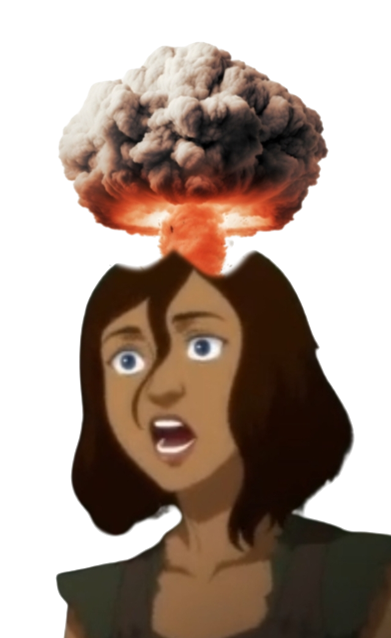
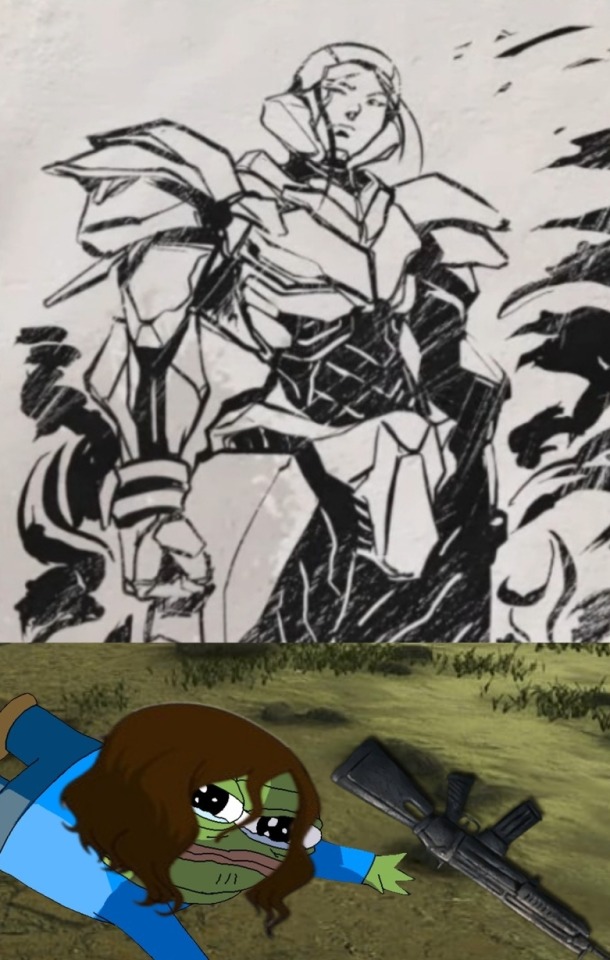
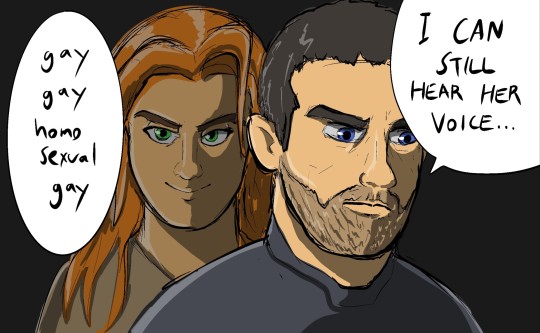

Some more ark lore memes found in the deepest pits of my gallery
#ark survival evolved#ark#ark lore#ark art#diana altaras#mei yin li#helena walker#ark aberration#ark the animated series#gaius marcellus nerva#santiago ark#ark extinction#ark explorer notes#meiana#ark survival evolved lore#yes thats an amphibia reference
38 notes
·
View notes
Text
sending out the call, people, give me movies or shows to watch that you'd recommend. currently isolating from family to avoid getting sick with the plague (you know which one) and this means i do not have access to my big boy computer that has all my video games and stuff on it. i just have my laptop. which is not nearly as beefy. and so i ask the people, things to watch?
#wick lore#mentioned that my laptop is wimpy bc (a) my pc is a gaming pc and built like a beast and (b) laptop wimpy = cant just download games#i dont trust this thing to run steam#also i do have a list in my back pocket of things to watch so if you're reading this far here are things already on my list#the dragon prince. amphibia. i saw the tv glow. nimona.#and things to finish or that i could start over#like in theory i do have enough thingses already but i feel obligated to inquire
17 notes
·
View notes
Text
I think a lot about that one theory pre season 2b where folks were convinced Marcy was gonna throw the music box in the fucking volcano in the third temple
#i wasn't there for it but I've read it and it's one of the most intriguing theories to me#what the fuck was all that about#i love fandom lore#they were unhinged for this#amphibia#marcy wu#text post
21 notes
·
View notes
Text

Hatsune Midori
Age: 14
Chara item: mint ice cream
Personality: she really likes mlp (especially equestria girls), Decendance (she's def obsessed with rise of red), Zombies (those movies were kinda mid), Ducktales (2017), Amphibia, TOH, the ghost and Molly McGee, monster high, ever after high, and rainbow high (also shadow high but idrk if I should count it as a different fandom). She likes to read + write fanfiction (and draw fanart), she's always talking about her favorite shows, she has the whole decendance soundtrack on repeat (the zombies soundtrack too). She's very shy, she only has two friends and their her siblings 💀. She's also a dandere, she's Silent, shy, timid, quiet, soft-spoken, sympathetic, asocial, insecure, self-loathing, cautious, sweet, gentle, vulnerable, kind, loyal, oversensitive, independent, distant, lonely, nervous, anxious, lovestruck, loving, affectionate, and cute
Voice configuration: bre 5 gen -30 bri 40 ope 25 cle 40
#vocaloid#fanloid#miku derivative#luxx's lore#luxx's art#decendants#amphibia#toh#the ghost and molly mcgee#ducktales (2017)#decendance rise of red#Zombies
11 notes
·
View notes
Text
It's interesting to see how Newtopia has like... the biggest axolotl population we see in any location in Amphibia. They seem to be second to newts there. In fact I think that, besides Loggle, we only ever see axolotls in Newtopia? And through all the little towns the Plantars visit during the first few episodes of S2, we see mostly frogs, and I do remember the show bible saying frogs are the majority, and we have evidence of that being the case at least in the south of Amphibia... while there are barely any if at all in Newtopia. There's... uh... Hop Pop's capitalist friend? Man I need more Amphibia demographics lore but especially I need axolotl lore. They're the only amphibian species that doesn't get any worldbuilding even though they're so iconic! And i love their design! Ugh I need axolotl lore! Why are they all in Newtopia? Why are almost all newts we see in Newtopia too? Frogs and toads are found scattered across the continent (though there are a lot less toads than frogs) but the newt and axolotl population is so heavily concentrated in the capital... I need to know the history behind this configuration. I need it so bad.
#amphibia#my posts#give me the LORE#i also need to make an analysis of toad characters and their occupations#i have the feeling almost all of them are either in the military#or they're bandits#which is pretty much the same but still#stumpy is the only one I remember having a peaceful and morally acceptable job
20 notes
·
View notes
Text
State of California
I already implied multiple times how different yet imperative California is now in the BNHA-AU. How now there is a new ethnicity due thr mixture of Latin and Anglo (mostly Latin culture) culturr including a new language, how there is a new religion originate from here that now dominated Latin America, and just how different it is from today.
California is still have some similarity from today however; Sacramento is still the capital city with Los Angels still the most populous, it has the highest population (more than 80mil) and most powerful economy in the Union, and still important in the West Coast. Texas is still in second when it comes to population (around 50mil) and population, but ¯\_(ツ)_/¯. California also has the highest rail passengers by state alone, maybe similar to Japan ridership. It is likely it is only beaten by the Northeast corridor, but that region should have a population already at 100mil.
Geography
There is not much change when it comes to geography. It is not like there suddenly are topical rainforests (California actually has temperate rainforests). However, thanks to activists, technology, and laws, many damage to the environment by the Climate Crisis were alleviated. Many Redwood and Sequoia trees managed to reclaimed historic range and then some. There are bisons roaming California, too, with extinct animals brought by to life like mammoth and ground sloth, and mythical creature. California also change their agriculture practice, emulating how Dutch cultivated their products, using greenhouses, hydroponic for efficient water saving, etc. I not going get into more detail (go watch a YouTube about Dutch farming), but this method allowed majority of Central Valley be reclaimed by nature, making the land looks like what it did in the 19th century: Lake Tulare is now permanent, marshlands and has a huge delta.
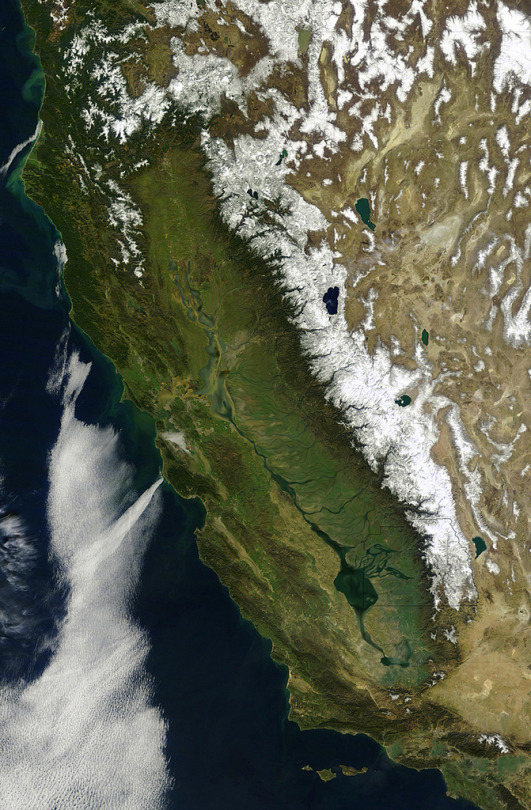
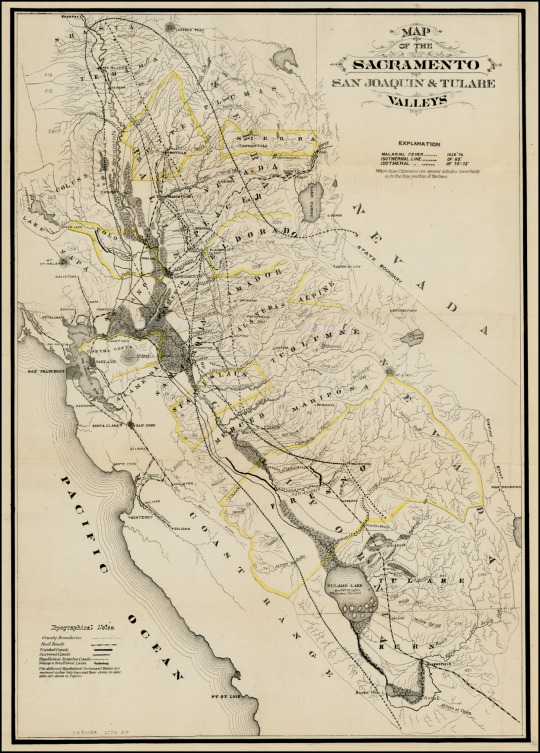
California also deurbanization (actually desuburbanization) many sprawling cities across the state. For instance, the cities I used to live in -Brentwood and Discovery Bay - are now gone, paved out. Many cities, especially in CV, have greenbelt, which also act the limited of their jurisdiction. I also think, with the Climate Crises alleviated, sea levels will drop by a meter or so, so now half of San Francisco Bay, especially south of San Mateo Bridge, is gone, mostly just salt marshes (and no, there are laws forbidding development on it).
There is a bit more rain due to El Nino and La Nina weather system now having a precedence. Like 2-3 years Nino and then 2-3 years Nina. So there could be a drought season. However, those also mean there's a lot more run, even during the mid-spring to mid-fall in Nino. Tropical storms are not uncommon during Nino, at least 1-2. This also means California will lose like a quarter of their desert are gone, so Antelope Valley and San Bernardino Valley biome are similar to Central Valley.
Cities
Bit difficult to talk about cities since some cities changed their name, some new ones, and that I need to make a map. I gonna try to convey the city position by only referring high population, North to South.
Redien- (Redding)- 500k. Know for rail connecting to Redwood Empire Corridor and to Oregon, high percentage of non-Kalifornáns, and high population of Therians/Lycan (Enid lives here).
Bí-Sierra (changing the name)(Chico) - 400k. Know for: ¯\_(ツ)_/¯
Yebu -250k. Know for: ¯\_(ツ)_/¯
Sacramento - 5mil. Know for being the capital, HQ of Golden State Railway Company.
Metropolis of San Francisco - 17mil. Know for the birth of Califity, Memorial of Califia, Angel of the Bay Statue (looks like a Japanese woman wearing a kimono, also know as Liberty of the West)/Museum of Asian and Latin Fredoians between early 19th century-1950s and Beyond.
Amid-Tu-Rifã (changing the name)(Stockton)- 500k. Know for looking like Venice and Amsterdam.
Tuolumne-ín-Estanislao (Modesto) - 500k. Know for: ¯\_(ツ)_/¯
Santa Cruz - 120k. Know for beaches and UCSC.
Salinas -1.2mil. Know for just having an HSR train.
Monterey -90k. Know for the aquarium.
Lafenia [Lafenã means Lavander in Californin (Madera)] - 3.5mil. Know for having the HQ of Rolosron (Golden Iron) Company (focus on rolling stocks), SU Laféna (focus on urban design, transportation engineering, and architecture), and vocation on public transit course.
Fresno - 3.2mil. Know for not being Fresno anymore and a dry port (ironically, it's adjacent by a massive river).
Nés Nakiśa (City near Visalia, between Tulare and Tipton)- 2.5mil. Know for being named after Nakiśa the Lover, the Innocent, and the Miracle-Worker.
Nés Anaís (Bakersfield)- 3.7mil. Know for being the birthplace of Anaís, the Lover, the Guardian, and the Martyr.
Santa de Nagasaki, also called Sanagi (in Santa Maria Valley) -6mil. Know for being a cyberpunk-like city (dont know if that's a good thing or not), cyberware and powered suits industry, and the few pro-hero academy in the world meant for non-quirks. It was a former city-state between the Dark Age to 2200s.
Santa Barbara- 200k. Know for just being a nice city.
Metropolis of Los Angels - 24mil. Know for the Gate of Angels (mixture of Brandenburg Gate and Arc de Triomphe, at San Fernando City), Los Angeles Central Station (mixture of Penn Station and Grand Central Station), Los Angeles Grand Park/The Meadow (bigger than Central Park and Golden Gate Park, at the former city of Compton, adjacent to LA River), The Sequoia (think Tokyo Skytree, have branch-like Observation deck, 670 meters tall, somewhere between Mid-Wilshire and Koreatown).
Rifãsíd (Riverside)- 500k. Know for ¯\_(ツ)_/¯.
San Diego- 9mil. Likely just the same as today.
All together, this brings it up to 78 mil people. There are other cities, towns, and villages in California like Eureka, towns around Lake Tahoe, and others around, but theses cities are considered either major, well-know, or important. All these cities, with the exception of Santa Cruz and Monterey, are connected by NAHSR, and Sacramento and Los Angeles are connected to the Continental wide Maglev network. I gonna explain California railways network later.
Most of the cities kept today boundary, however demolishing many of its sprawling suburban housing. Like I said before, most cities city boundary are tangible by its greenbelt, and they can't, by state-law, develop pass it unless their km density passed 25km, which many city, especially in Central Valley, haven't pass it. Actually, many cities in the Valley have an average of 250km land areas, with average of 12k km2 density.
Many cities, but especially to SF and LA, have patches of urban forest. Not parks meant for recreation, but forest that is meant for nature. SF and LA have many patches of those urban forests, many usually 1 km² but could be higher than 100 km². They used wildlife crossing to connect them all.
Many cities looks like a mixture of futuristic architecture (I will talk about that later) and somewhat traditional-like like Isabelan architecture (eclecticism of Spanish Colonial and SF-like Victorian architecture, need to talk about that). However, Sanagi is just straight-up cyberpunk city, like I will call it Capital City of Cybernetic, with having an unusually higher percentage of Non-Quirks. Non-Quirks are more likely to installed cyberware than Quirks, to the point majority of their bodies is cybernetic. (Lets not kid ourselves, with BNHA having robots the size of skyscrapers and artificial islands in the middle of the ocean, yeah they will stereotypical cyberpunk technology.)
Economy
I think I hinted this before, but California, and frankly majority of the world are what I considered social democracy, or at least, some form of socialist. In California (and Fredoia), almost every necessity goods or service like water, energy, internet, healthcare, public transportation (including airlines), etc. is own by the government. Meanwhile, some that considered necessity but needs some in-hand by the people like housing (majority of it), foods, etc collectively owned either by neighborhoods (districts), groups, or guilds. Now I think about it, it kinda similar to Post-War Britain, especially how it comes to Attlee policies.
In California, the state has a market socialism and guild socialism (Democratic Socialism). There are companies that are controlled by employees; democratically elected company leaders, a 1 to 5 ratio wages, input how the company should be headed, etc. Half the company stock is owned by the employees, and the other half is owned by the local governments, which is then controlled by the people. They voted how the stock revenue should be allotted and apportioned accordingly (either funding for transit, schooling, maintained, etc.). However, sometimes, thanks to public banks, they will give denizens the money through all the stocks in the city.
For guild, sometime a mixture of labor unions, company of laborers, or craftmanship. Many cities have guild in it jurisdiction. For instance, and this I have an idea for a while: biking is considered a one major ways of transportation in California. Because of that, bikes is a huge industry in the state, bikes repairers and retailers are common in cities. A guild that focus on biking will required those to join to and gain a permit. The permit is meant for laborer protects, universal bike parts, . Meanwhile, customer who have a warrant for the city bike guild could go to any bike repair: if they broke their bike kilometers away from their usual repairers, they could go to a close by repair shop and have it fix free thanks to the guild warrant.
Another city guild/company is like a group of crafter who also works together, but unlike something like a bike-like guild, it act more like a company whose own/control/manage by the city, like for construction company. It will be more efficient since the city will have experience with laborers, more efficient in talks and shit, and if there is unneeded constructions, many laborers will simply be put on paid leave (which kind of unnecessary because California is always either building or maintaining something lol).
Agriculture is owned by small farming communities. Honesty, they likely lived in Tipi-like housing similarly what I talk about in my last post. Their farming is just straight up just like the Dutch, which give higher yields for hecto without needing to use more lands. The government will give the community findings and buy their products so to keep foods extremely low. the government will then sell it, low price, to merchant/retailers who then sell it to consumer in again, low price. However, 1/3 of foods product in California is grown by urban farming.
The majority of housing is collectively controlled by locals/tenets. I based it on Singapore town council and House and Development Board. I know that anyone who knows about this is probably not a good thing, but the other synonymy or trying, think of example is Homeowner Association, which is worse. Each city (or ' special wards' for metropolis cases) have districts, which democratically handled housing (and other buildings). They also have delegates for the city council. The district receives tenets rents and is handling it by either paying utilities, repairs, or insurance (not like insurance company, "just-in-case" like natural disasters, hero/villain's battle, etc.). Prices are dependable on housing types (a duplex will be more expensive than an apartment, while a town house be more expensive than a triplex), rooms (if you have kids, the price will be lower), floors, material of the building itself, and construction method. But price are all fixated, meaning if there a housing that have all the characteristic in two different location, and one is consider far more desirable for its surroundings, the two housing are still the same price. In today markets, we usually handle this by outbidding another buyer, which increases house prices. This is the reason why San Francisco is so expensive. Instead, California housing is handled by a lottery system, fairness by fate instead of higher monetary. Some participant are allowed to have some advantage depending on their situation: if they live in the district/city majority of their life, if they have a family, they lost another lottery, they are about to be homeless soon, and such. Ironically, Frinsica (San Francisco) is still difficult to get a house there, lol.
In housing there, people either rent or buy housing. By renting, it usually cheaper- if we using today renting price, an average price for like an one room apartment will likely be $150 per month (people have limits of free utilities until hiting that limit. Parking isn't included and is optionable since like more than half of California doesn't have a car). It's for people living short-termin the area, occasionally students for either high school/college who doesn't want to live in dorms/SRO, newly adults, or people who simply want an easily life (which is not stigmatize in California). However, it usually has a maximum limit of how long someone could rent there (usually 5 years), so people are either evicted or pay an expensive extension. Buying a hosing is also preferable and also cheaper than today. I don't know what is considerably an average price, but likely a triplex unit will cost $150k (you not owning the entire building, just the unit. You do collectively share it with two other owners). Buying is likely similar to how Singapore housing (go look at a YouTube video, lol). One thing to note is that the owner cannot sell their unit or rent it to another tenet. They could only sell it to the district, which would likely be the same price with 5% add. The owner could allow their unit to be inherited or allow friends/families/associates to live in it, but that likely it. Selling or renting it will defeat the purpose of a lottery system.
There is a national bank, a public bank owned by the federal government. Each state have their own banks which connected to the federal bank. The benefits is there is no monthly fees, withdrawing money from other state bank atm without fees, easier gaining loans with lower interest rate (great for starting business ), better retirement account which also connects to social security. However, there is a limit how much someone could have in their account before they start paying a monthly fee: $100K, and the fees gets much higher along with the saving account. (Also, it is common for people to have two retirement, the average lifespan is 160 years, and there are also quirks that allow some people to have longer lifespans).
For artisan guilds like for writers and artists, there is likely an universal-like wage so writers/artists could allow to do their craft. However, there is likely a quota/requirement so they actually do what they meant to do.
For exports and well-known sectors, it likely will be the same as today with some key differences. For one, they know for rolling stocks, specifically for HSR, metro rails, and trollies. The company that handles it, Rolosron, is located in Laféna. Another is Kalimé, or sometimes called Kaliniśon, animations production in California. It has their own unique style, similar to anime in Japan: inspiration, and how I think it will look like are SPOP, Gurihiru works, and some comics like Specter Inspector. Produced in either Los Angeles or San Francisco. Cyberware is also well-known, many of which are produced in Sanagi. Maybe also biking manufacturers, revenues from Califinitan pilgrims, and likely that it.
Half the main energy source are renewable, including solar energy, wind energy, ocean tide, and hydroelectricity. The rest is nuclear fusion plants, and when I mean plants, I mean there are only four plants in the entire state (they needed imported huge amount of tritium gas, also yes, there are still fission plants). There are also room-temperature superconductors, which it is not as common so its usually use for either fusion reactors, transmission tower (almost all California's wind power comes from the Great Plains), energy storages for cities. They are also getting into the noireau (metallic hydrogen) industry.
California working hours is 6 hours, and could only work for 4 days. Cause of this, they have 3 day weekend. In Califinity, they viewed that person must time in three order: Friday for resting, Saturday for indulgence, Sunday for praying. They also get 2 four weeks vacation and 1 three weeks of vacation.
Transportation
YEAH! This is the one I waiting for; I keep indulging about California having an intricate rail network. For now, I gonna talk about non-rail transit because I dont fuck around with trains.
The majority of California used rails for transportation, with Los Angeles rails having 28mil passengers in a city of 24mil (wondering how, go look at Tokyo transportations section in Wiki). However, there are many people who also use either the bus or are preferable to either walk or bike to their destination. There are people who uses cars, but it a privilege to use it, and expensive too: there is congestion charge, parking fees, registration fees for battery cars, high taxes for either ammonia or noireau fuels , and high tolls for using Interstate/Expressways (maybe like $1000-1500 for per year, and higher for freight trucks) (many freeway/interstate were demolished in inner-cities however).
Not only that, many cities have streets design that are similar to Tokyo and European cities: having few boulevard that connect the city in boarder scale, but have streets that either one-way, or pedestrian only zone.
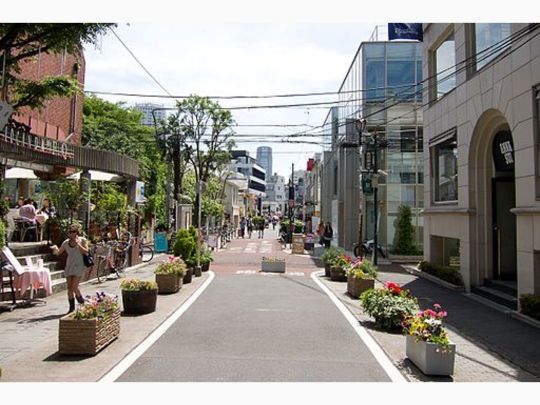
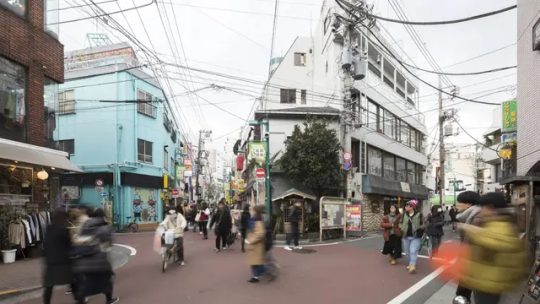
This kind of street are very common in California cities.
California owns a state-enterprise airliner, Golden Airline. There are only 5 major airports in California, 3 that deal with international (as in, non-UNEC member)/intercontinental destinations): San Francisco International Airport, Los Angeles International Airport, San Diego International Airport, East Bay Transcontinental Airport (Oakland Airport), and Santa Ana Transcontinental Airport (John Wayne).Not only are there fewer airports, but intrastate flights are banned in the state. Thanks to federal law, constitution, and UNEC, flights are also banned to Oregon, Nevada, Arizona, Navajo-Hopi, and the State of Baja California.
Rail
California owns a state-enterprise that deals with rail passengers called Golden Railways Company (HQ in Sacramento). Actually, it is one of seven subsidies of Amtrak, which is far larger than today, to the point there has to be smaller companies to deal with railways. The other is Lone Star Railways (Texas and California are the only states to have their own railway companies; HQ in Austin), Northeast Railway Company (Northeast region including Maryland and DC, HQ in New York City), Russet Railway Company (Midwest States that isn't under Lakotah lands; HQ in Chicago), Cascadia Railway Company (Oregon and Washington states; HQ in Olympia, WA), South Railways Company (can't think of a good name lol, compassed all other Southern States; HQ in Atlanta, GA), and Sunwest Railway Company (Southwestern States including Idaho, Montana and Wyoming (any left over lol); HQ is maybe either in Phoenix, Santa Fe or Denver).
California has a massive railway network; it's possible to go to any destination via rails in the state, via regional corridor like the Redwood Empire Corridor (talk about that soon), or intercity/hsr. California two important corridors; the Golden Corridor that goes through Central Valley all the to San Diego (and connects to other states and countries), and the Southern Range Corridor (also called Salinas) that started in San Francisco, goes through Salinas Valley, to Sanagi, Santa Barbara and then Los Angels.
The Golden Corridor used the legacy route of CAHSR, a project that, despite its flaws, was fundamentally crucial for the state. I gonna digress for a bit but people bitching about how the route "should be shorten" or go pass certain cities missed the point. California does not have a good connection with its cities. Yeah, there is Amtrak, but the issue is that it is too slow for conveniences, many of its tracks are owned by freight companies, and there are no direct routes for SF-Fresno-LA. The reason why there is such high population in Central Valley is thanks to CAHSR (and other things). The only reason there is some route change is because there are always things to improve on, some cities are just gone, and there are other routes that don't need HSR.

(What the majority of GC looks like)
There is some new routes and changes of route. For one, it goes further norths to Chico, Redding, and then to Oregon. Another is the corridor at SF-Jose. Right now, CAHSR will share with Caltrain, using the same rails. It is great because it electrified the rails. However, there are some flaws. There are still level crossing, which, admittingly, some are being constructed to have grade separation. Another issue is that it has double-track railways, and it's in the middle of an urban environment.
A few decades after Califia's death (maybe 2080s to 2090s), California has somewhat of a rail revolution, transforming the state railways. For one, the state converted half of state route 101 (SF-Mountain View) into quadruple-track railway. The benefits that it allows HSR trains to go faster, allowing other trains to share (the Bay Area has a RER/S-Bahn trains), and is more separate from urban neighborhoods. The corridor split off from MV: one goes to San Jose Central Station (dual-track again), another still going along US101 than merging with IS880 (still a quad-track). The former Caltrain corridor is converted into a BART line (which is owned by BATA- Bay Area Transportation Authority/likely succeeded Seamless Bay Area). Once the corridor enters SF, it follows the same route of US101 (there is now freeways in SF), which, instead following CAHSR terminating underground, it goes to SF Central Station at the former IS80 above ground. It's a through-station and follows into SF-O Bay Bridge, which either goes to Oakland 16th Street Station, or continues to Sacramento. The Bay Bridge (Golden Gate Bridge and San Mateo Bridge too) itself is similar to New York Manhattan Bridge and Brooklyn Bridge: railways in the bottom, 3x3 road, and a pedestrian/cycling route atop.

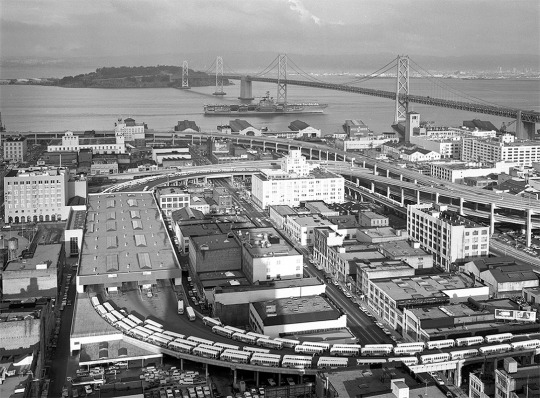
(Where SF/Frinsica Central Station will be located. Also note this is the only way for cars to enter the bridge. Also, i am hitting on my image limit, lol.
For the majority of the corridor, from Sacramento to San Diego, the majority is quadruple-tracks. Well, maybe six-track if you count Maglev, it fellows the Golden Corridor. Also, San Francisco is the largest city in Fredoia that doesn't have a maglev station (lol, lmao even). Some cities are gone, so the corridor does not stop there. Kings/Tulare is Nés Nakiśa, the one near Visalia, and then to Nés Anaís. If a city is adjacent along the corridor, it will have a station, but the HSR will bypass it. There are also minor corridors that connect to the Golden Corridor. Best metaphor, the Golden Corridor is an artery that connects capillary.
After Bakersfield, it bypassed Palmdale and continued to Burbank/LA. Like I said before, Palmdale is connected to the Golden Corridor and does have it own Corridor, its only that HSR does not go there. After LA, it continue down south; it does not go west to San Bernardino. Instead, it continues journeying to Anaheim and then cutting through Chino Hills towards Riverside. From there, it either goes to Las Vegas and/or Phoenix and/or Jeddito and the rest of the country. Or it continues to San Diego, Tijuana, Mexicali, and then all the way to Mexico City. It is quite common for Californians and Mexicans to travel for either places thanks to UNEC having a open border policy.

(Notices how once stopping at Riverside, it either goes south, north, or northeast). (Also, I mention before and forgot to said it here, HSR can go up to 450 kph (average likely 400 kph). How they achieved this, other then making sure the corridor is as straight as possible is by: having wireless power transfer beneath the tracks (not eroding the overhead lines), concretene (concrete that has graphene mixed in it) to withstand the vibration and have longer lifespan, and nistíl (neo-steel which is my own idea; just steel itron mixed with graphene) which also withstand the vibration, friction, and have a longer lifespan).
The Southern Range Corridor, or the Salinas Corridor, is another corridor that meant for HSR. The Golden Corridor became extremely congestion: not only regional and HSR trains are using it, but also interstate and international trains frequent the route. So GRC constructed another corridor (likely in the early 2200s) to alleviate the main corridor traffic. It also has many cities in this region, especially Salinas and Sanagi, that don't have proper train lines. The corridor started from Gilroy. Instead ofgoing east, it goes south, going to Salinas. Then it goes southeast through Salinas Valley, continuing all the to Paso Robles. Then it goes south through the mountains, going through San Luis Obispo, then stopping at Sanagi (Santa Maria Valley). It then goes southeast again to through another hills, stopping at Santa Barbara, then through the mountains again to Ventura, goes to Oxnard, Camarillo, and then to Los Angeles Central Station.
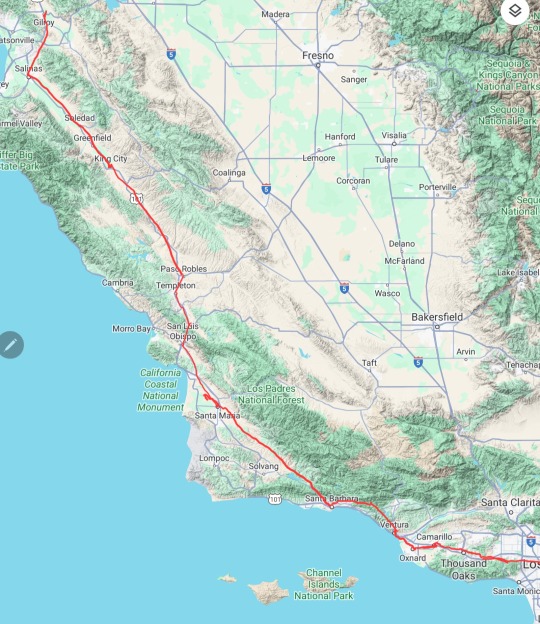
(What the corridor looks like)
Now, the Golden Corridor and Salinas Corridor aren't the only corridors, but those two are the most important, having HSR lines and high traffic. There are other corridors in California, local/regional ones that connect to either corridors. Small traffic yet crucial. One corridor I want to talk about is the Redwood Empire Corridor.
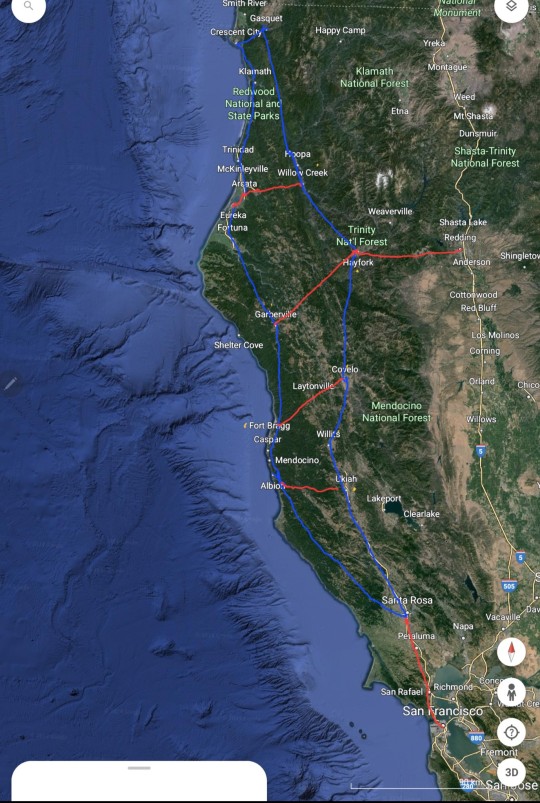
(red is dual-tracks and blue is single-tracks)
The Redwood Empire population, minus anything south of Santa Rosa, is around 750k. Once past Santa Rosa, the corridor goes in a counter-clockwise. The red that goes east-west allows the line to form a 0-shape route. There is like an average 15-20 on the line. I got the idea from Not Just Bikes video about Switzerland. Thanks to this, there are far more people who travel to Redwood forest, especially in spring and summer. There are other corridors in low-populated regions that use similar routes.
The state entire uses clock-fast scheduling- arriving or departing either at 0s or 5s- and pulse timetabling.
There are different categories and types of rail trains, basing it off from Germany and some from the UK. The reason why those two is because it's the only one I can find in Wikipedia, lol. Usually based on how important the hub is, intermittent trips, number of passengers daily, and huge the building is. If I properly made a category list, LA and Sacramento will be 1 (having a maglev stop) while San Francisco and Lafénia will be 2 (not having one. Also, being the last stop before an important junctions is the reason why Lafénia has such a high population).
Education
Before I startn I need to remind everyone that the average lifespan is 160. This means that people ages slower, including sexual maturity like some animals like giant tortoises and bowhead whales. So there people in their 50s who looks in their 20s, or in their 90/100s who looks like in their 40s, similar like Aragorn from lotr (this also means women/afab are averagely 2-3 inches shorter than men/amab, and menstrual cycle is 60 days. Average Ostrace age is usually 200-250 excluding Kitsune and Sanguinarians). So schooling lasts a bit longer than today. (Also, California schooling is implemented country-wide with some difference.) There are laws that require schools to be surrounded by pedestrian-only streets. School days are Monday-Thursday. Some schools also have Friday but it is only half-time
There is 4 levels based on age:
Elementary school, also have daycare :0-8
Primary School: 8-12
Lower Secondary School: 12-16
Upper Secondary School (referred to as Liséa in Kalifornán): 16-20
Elementary schools are far more common than the other 3 schoolings, with an average 1 elementary per 1.5 km. The reason is that is so young children could be closer to their schools. It compassed pre-school, kindergarten, and Grades 1 and 2. Elementary teaches students their primary language (Kalifornan), basic math, and such. An average elementary will likely have a body of 100-200 students, with teachers having a class of 8-10. The elementary playground will also act as a local park. Elementary students are also called Ducklings due teachers picking up their students and herding them to schools like a parent duck and students wearing bright coats.
Primary schools are a bit more widespread due to students being supposed to act more independently, maybe like 1 per 5-10 km. Students are supposed to learn their second languages (usually either English or Spanish, but in some cases, a different language if the neighborhood has a large non-Californian population). An average class has 10-12 students with 500 per school, and students stay in the same class all day. Parents pick their child schools. Schools last 8:30-1:30
Lower Secondary School is widespread too, with 1 LS per 10-20 km. Students again will learn another language, learn more complex subjects, and such. Average classrooms are 12-16 and like PS, students shared same classes. Students are allow to pick their schooling when entering Lower School. School last 8:30-2:30.
Upper Secondary School (or Liséa in California) is far more widespread, with 1 per 20-40 km. Unlike the last three, students do not share classes but go to classes individually. UP acts more like a university than the other schools. Students may learn another language, but it is not mandatory. Not only students may choose their schooling but they could go to another city's schools if desire. It is common for students from small cities and towns to go to bigger cities like SF and LA for schooling (staying at either schools' dorm, social single-room occupancy, or renting an apartment). Students also gain a counselor who guides them for post-US life and careers, especially if it's related to their quirks. It is dependable on the student's schedule, but Schools last 8:30-3:30.
From Primary to Upper School, all students are required to wear an uniform. However, dress code is only not strict but students are courage to customize their uniform, embracing California social individualism. Gender restricted is illegal, and students, regardless of gender, are allowed to wear either pants or skirts. In fact, it is common for boys and masculine genderqueers to wear skirts during summer classes.
Classes scheduling is dependable on cities and their school district, but there are causes where classes have hybrid scheduling of Block and Timetable, with all 8 classes the first Monday, and A/B for the rest of the week. However, some classes, like language and math, are required to be held daily. A school year lasted from late March-Late June = 4/5 weeks vacation= Early August-Late Nov./Early Dec. = 4/5 weeks vacation = Early Jan - Mid/Late Feb = 2/3 weeks vacation = New School Year.
There is a new legal status called Minor. When a student/child reached the age of 15 years-old, their legal status will be listed as Minor, a transition from childhood to adulthood. Under this status, they enjoy far more privilege than they did as a child:
Allow to consume alcohol that is under 5%.
vote in local election.
Go to doctors without parents permission and do minor procedures like HRT
Watch +16 movies at the theaters.
At age 20, they allowed to do:
Voted in State and National-wide election and run for local office.
Consume all levels of alcohol.
Watch +20 movies at theaters.
Allow to do major medical procedures like gender-assignment surgery.
At age 25, they allowed to do:
Run for state and national-wide lower-chamber office (upper chamber and executive branch is 35).
Join the military.
Allow to work in Pleasure Guild (adult films, sex workers).
Drive and operate machineries like cars, trucks, trains, planes, etc.
Culture
The majority of Californians are an ethnicity I already talked about, Kalifornán. Kalifornáns formed (how does a new ethnicity happen?) due to many other Latins ethnicities' culture, especially Mexicans, shared, borrowed, and merged their culture together with Anglo in California. The language, again called Kalifornán, formed from Spanglish. Kalifornáns is primarily found in California, but many are also found in either US states like Arizona and in Mexico states like Baja California.
Kalifornáns are usually energetic and cheerful, more so than non-Kalifornáns. They greeted one another with hugs and kisses on cheeks, regardless of gender (even in formal greeting, they do so, though only with other Kalifornáns). Informal and casual parties are common, lasting into 1-3 am. When guests come over, the host usually serves coffee like cafecito and some pastries. It is just like other Latin Americans' etiquette.
Small street parties are also more common, usually starting around 4-6 pm. Its due to how permits are not really required, only informing a police officer and asking permission of either store or restaurant owners if they throw one. This creates a stereotype of how Kalifornáns are always throwing parties.
Different gender and sexuality are far more acceptable and common in California, with at least 30% self-identified being queers. Even men who consider themselves cishet will wear skirts if the day is hot, and wear bright colors and showing off skin (think timothee chalamet venice film festival outfit).
In beaches and film, breasts are not stigmatized, and it's common for women or genderqueers with breasts to be top less (though some wears a wrap around their shoulder). Non-genital nudity in media is also non-censor and is known to be shown in media below rated-16. Breasts are not sexualize in California, they are more interested in hips, waists, thigh, and butts.
Kalifornáns celebrated their Quinceañera, regardless of gender. For Kalifornáns, especially Califinitans, a child reaching 15 years old, a Minor in legal status, is considered the second most important birthday of their life (behind their Awakenday). This age is considered a transition of childhood to adulthood, and so, many people celebrate their coming in age day. For girls is called Quinceañera, boys is called Quinceañero, and for nonbinaries and other genderqueers is called Quinceañere. It is commonly to celebrate Quinceañera-children all together in the end of the month, usually at a Califinitan temple, and the government pays half of the celebration.
It is common for Kalifornáns to have mini-vacation once a month or so, using their 3-day weekend. They usually preferred traveling 2 and a half hours away from their home, using HSR (hence the high ridership). It's also common for Minors, even young as 15, to have mini vacation by themselves or with friends. It also common for them to visit family or friends if they attend school in another city.
Kalifornáns usually started parenthood between their 40s-50s, usually having 2-4 kids. Parents use their parental leaves for childrearing; parental leaves could be used for up to 3 years, and both the workplace and government pay for their leave ( the workplace is only up to a year). However, it is common for parents to stay home up to six months, where either parents (or ternary or more parents) will agree upon a schedule where one either: work half day and the other take care of the child, one work full day while the other care, or do a hybrid with mixing both schedules. It's very common for families, friends, and amises (will explain that later) to help rear the child, including the community, too. Thanks to technology and different social norms, there are different ways to begotten a child: artificial wombs are becoming the most popular way, though queue are long. (For artificial wombs, gestation is much larger -16-18 months, but the benefits are that infants are more developed compared to natural ways. They will be born as a 6 months old infant and soon start crawling a month later). Vitro gametogenesis is already mainstream. Another method is synth-organ/glan: synthesizing tissue that does certain functions that can't be found in human biology initially ex: having a specific gland to filter carbon dioxide, or having freckle-like bioluminescent marks. Meaning, it is possible for ciswomen to have a synth-penis that produces estrogen and gamete and, likewise, for cismen.
In Kalifornáns, and frankly, Califinitans too, there are considered 3 important important group that fomrat into structures of an individual: families, friends, and lovers, and they all central around the person. In Califinity, one of the most important holidays (expect the day Califia death/transcendence) involves around this, celebrated in the first 3-day weekend of June (it is no coincident why it is in June). So, while romantic is important, platonic-ships are also very important. One such instance is called amís. An amís (or amise/amisa/amiśo) is someone most dearest, closest friend. A word that is similar to it is the Japanese word Nakama. Rarely will people have more than one amís. It is common between amís to have a civil union while also romantically marry to another person. Amís are known to be intimate, including cuddling, small kisses, and hugs (sex is uncommon but not unheard of). Amís will also raise child together, and sometime they will be both child biological parent. There is a genre in media that is meant for amís.
Snippet culture
Can't really think of categorizing this so I gonna type it out. Kalifornán parents don't genderize their child name. Since Kalifornán uses some Spanish rules, including grammatical genders (-a is feminin, -o is masculine, -e is nonbinary/genderqueer, and no vowels mean gender neutral; likely will use ä,ö, and ë), the parents uses gender neutral, and it's up to the child if they want a gender suffix.
It's common for children to call their parents by their first, especially if they're same-gender. For instance, Anne Boonchuy will usually call her mom Mami Oum. However, sometimes, they will have a nonbinary/gender neutral informal parent word, Parí (pair-e). Same uses if both parents are same-gender or one happens to be a genderqueer.
This isn't only done by Kalifornáns but also country-wide, but it expects for both couples to take each other's name, like how Latin Americans do so. For example, Anne Boonchuy full name is Anne Asnee-Boonchuy (Asnee is Oum's surname). Usually, women keep their mother surname and men likewise. Same-gender couple, like a sapphic couple, both will keep their mother surname and again likewise for gay men couple. Nonbinary/genderqueer couple or partner is a bit difficult, but they usually choose what name to keep or keep if one of their is nonbinary/genderqueer. There are also new surnames. (Disgressing a bit, but Emma Nolan full name is Emma Emdis-Nolan. The -Dis suffix means "daughter," and Em- is shortened for Emma. Also, she has two mothers, but she still gets disowned due to being a non-quirk (oof). Also, she has six other sisters).
There are some new dishes, one is which is sandwich/taco-like. It's similar to roujiamo (Chinese sandwich, which half the bread is halfway slice before stuffing food into) with using arepa (or any other flatbread). The bread is slice halfway, and then hallowing it inisde. Then, the ingredients uses spiced and shredded grilled meat (usually chicken), shredded lettuce, diced tomatoes, cutted green onions, maybe diced of white onions, and condiments of sour cream, and either BBQ or thousand islands sauce.
The majority of Southern California are non-Deitist Califinitans, and Northern California are Deitist Califinitans (especially in the Bay Area and Central Valley).
Romantic relationships with age gaps will likely be more common due to longer lifespan, especially if dating an Ostrace. Yoko Tanaka is likely twice the age of Divina, though Sanguinarians ages even slower than an average Ostrace. It will not be surprising if, say, a young Japanese lesbian dated a Kitsune and found out she was alive when Matthew C. Perry went ashore on Japan.
There is a balcony culture, similar to what Montreal has. Since most people in California don't own a single detach housing anymore, and that many housing has a balcony, people will convey their balcony in their own liking. An average balcony is likely a bit smaller than an average room, half which jutted out from the building. There are a lot of hanging plants, many of which are flowering that dangle from it (I based it on Cartagena historic district), and it is common to see people having conversations from across one.
Popular sports are association football that doesn't revolve quirks, girdfield that use flyers (flying broomstick) and non-mage-kind could play, and Metaball, which is the most popular sport in the world. Metaball is a quirks sport, meaning a person needs to have a quirk in order to play. The rules are malleable depending on players, but everyone is required to use a soft exosuit. Capture the Flags is also popular, which is mostly a pro-hero game that heros, usually forming a team based on their cities and playing against each other. The game could escalate very fast, and it is popular on pro-hero academies.
Don't know what else to talk about. The justice system is vastly different, like police officers (other than requiring to have some sort of degree) can't carry lethal arms. The US has a gendarmerie force, the National Guard, which revolves usually against highly dangerous quirks (justice systems are not allowed to use the term "villian")(raiding, capturing, and transporting), internal security, and all that stuff. Pro-heros operate differently than Japan, which are like private cops. Pro-hero is another branch of the National Guard, meaning it's a gendarmerie, different from that they focus more on their quirks individually. Pro-heros usually are put in team, squad, and operate individually and occasionally as teams like Justice League and The Avenger. The highest ranking team in the US is called Liberty Paladins, which usually involves protecting both the prime minister and president, dangerous missions, and stuff (California hero team is called Golden Costodian). Also, during the time of war, Peo-heros will act and operate like soldiers.
Pretty much that it. I planning on changing the US name, somewhat similar to Saoirse, got inspired watching a sex scene of Saoirse Ronan with Charlotte Murchison and I kinda like that name.
#bnha#boku no hero academia#my hero academia#mha#bnha au#mha au#bnha fanon#bnha fanfic#mha fanon#mha fanfic#bnha fanfiction#mha fanfiction#enid sinclair#the prom#railway#trains#high speed rail#urban#lore#sci-fi#sci fantasy#socialism#leftism#left wing#wednesday netflix#queer#yoko tanaka#divina wednesday#amphibia#anne boonchuy
8 notes
·
View notes
Text
ECHO'S KIN LIST
Characters I kin because I feel like I am looking in a mirror, and it genuinely scares me sometimes:


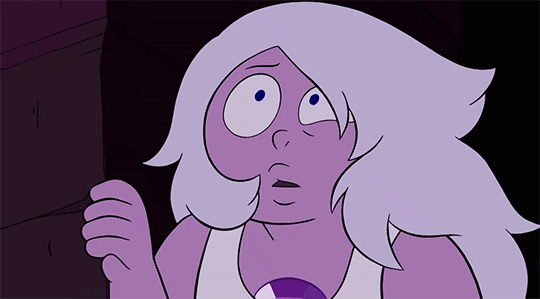
Characters I kin because they have certain personality/behavioral traits that I also have:

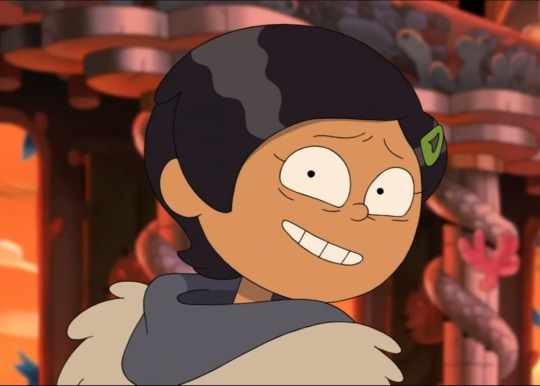

Characters I kin but I can't quite figure out why:


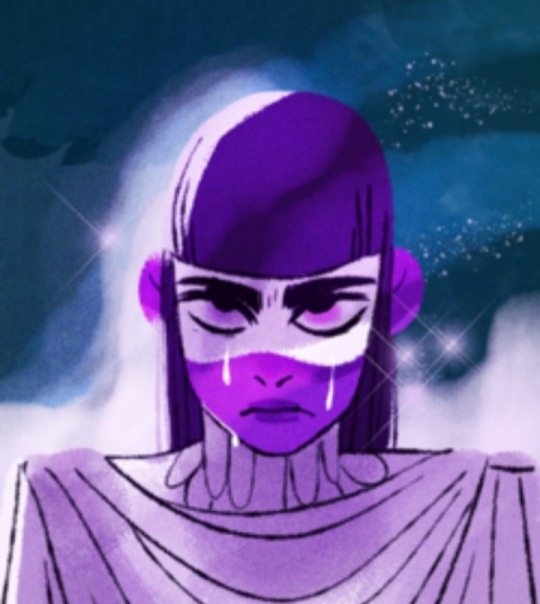
#the owl house#the owl house luz#luz the owl house#toh luz#toh#luz noceda#amphibia#amphibia anne#amphibia anne boonchuy#anne boonchuy#amphibia marcy#amphibia marcy wu#marcy wu#steven universe#steven universe amethyst#su amethyst#amethyst#lore olympus#lo hermes#lore olympus hermes#lore olympus artemis#lo artemis#helluva boss#helluva boss blitzo#helluva blitzo#cuphead#the cuphead show#mugman#teen titans#teen titans raven
53 notes
·
View notes
Text






happy "what the fuck matt braly" day to all those who celebrate
94 notes
·
View notes
Text
Dust, maps, and reference rooms in "If You Could See Love"
Haruno and Fukatsu look for a world map in the social studies reference room At the end of the second chapter of If You Could See Love (also named Moshi, Koi ga Mieta Nara), two of the protagonists, noted above, look for a world map in the reference room. They end up finding the map, with Haruno, who is physically weak, helped by Fukatsu, with Haruno relieved. The love between them blossoms, as…

View On WordPress
#Ace Attorney#Amphibia#archives stereotypes#Arlene Schmuland#dusty#female archivists#Hilda#If You Could See Love#lesbians#Little Witch Academia#Lore Olympus#maps#newspapers#Phineas and Ferb#physical disability#reference#short blogs#Stretch Armstrong#The Bravest Knight#The Ghost and Molly McGee#Vowrune#yuri#YuruYuri
2 notes
·
View notes